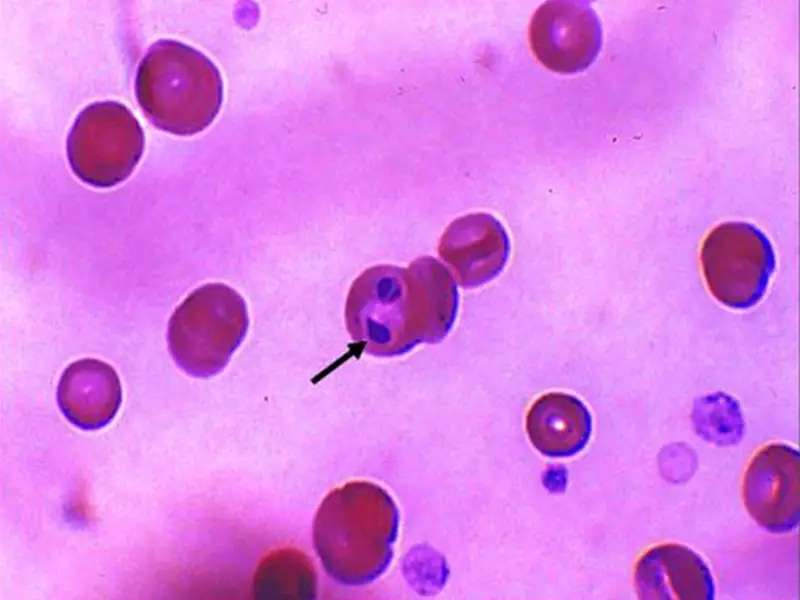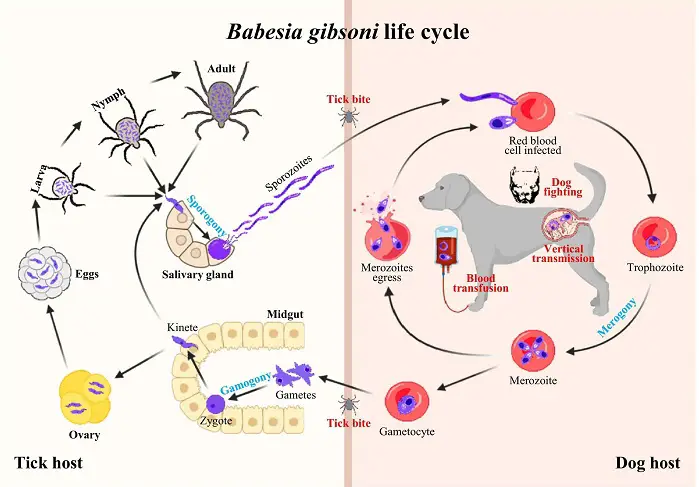Babesiosis in dogs is an infectious disease caused by a tick-borne blood protozoan. The protozoa invade mammalian blood cells and destroy the red blood cells. Babesiosis’s outcome is fever, anemia, and death due to severe hypoxia. Babesia is a global problem, especially in warmer parts of the world.
Importance of Babesiosis in Dogs
Dogs are affected by many diseases caused by bacteria, viruses, fungi, protozoa, and noninfectious causes. Babesia is one of the deadly dog diseases caused by intracellular blood protozoa. Babesia organism invades RBCs, multiplies, and destroys the cells. Destruction of blood cells causes anemia, fever, jaundice, hypoxia, and death.
Causes of Canine Babesiosis
A blood protozoan species cause piroplasmosis in dogs. The organism has a different life cycle and needs two hosts to complete its lifecycle. Several species of ticks act as vectors, and dogs, cats, cattle, horses, sheep, goats, and other mammals act as primary hosts. The babesia species responsible for canines are as follows:
- Babesia canis.
- Babesia gibsoni.
How a Dog Gets Babesiosis?
The biting wound of Ixodes ticks primarily transmits the Babesia organism. The infected ticks carry the immature protozoa (merozoite) and transmit them to the definitive host (dogs). The protozoa then invade the RBC and mature. After maturation, they destroy the RBC and infect other blood cells. When an uninfected tick sucks blood, they get infected by the dogs.
The other form of transmission of canine Babesiosis are:
- Transfusion of blood from an infected dog.
- Transplacental transmission.
- A healthy dog bites an infected dog.
Pathogenesis of Piroplasmosis in Dogs
The RBCs are infected by parasites and destroyed by replicating Babesia organisms within the cells. The RCs also destroyed by immune-mediated reactions against the parasites or self-antigens. The resulting destruction of RBCs leads to anemia, hypoxia, and death of affected animals.
Risk Factors of Canine Piroplasmosis
The following conditions of canine piroplasmosis are:
- Excessive tick population in kennel or yard.
- Hot and humid conditions.
- Summer seasons of the year.
- Poor tick control.
- Poor grooming.
- Contact with infected dogs.
- Lack of screening by a blood test.
Clinical Signs of Babesiosis in Dogs
The incubation period of Babesiosis is from 10 days to three weeks. Babesiosis may be an acute, peracute, clinical, or subclinical infection. The most common clinical manifestations are as follows:
- High fever (103° F).
- Increased pulse and respiration.
- RBCs are destroyed by intracellular parasites, which leads to anemia.
- Pale mucous membrane.
- Depression.
- Weakness.
- Anorexia.
- Hypoxia from rapidly developed anemia.
- Jaundice, petechial hemorrhage, and hepatomegaly are present in some dogs.
- Affected dogs become restless.
- Varied degrees of constipation.
Diagnosis of Canine Babesiosis
The presumptive diagnosis is based on the area’s characteristic clinical signs and history of the tick population. The confirmatory diagnosis is based on the identification of Babesia organisms from the blood of infected animals.
- Detection of antibody titers to Babesia spp using the indirect FA test.
- Giemsa staining of blood smear prepared from affected dogs.
- Detection of DNA by PCR.
Differential Diagnosis of Canine Piroplasmosis
The disease is confused with the following diseases:
- Hemolytic anemia.
- Thrombocytopenia.
- Jaundice.
- Redwater Fever.
Treatment of Babesiosis in Dogs
The treatment protocols for Babesiosis are as follows:
- Blood transfusion from a healthy dog if the anemic condition is severe.
- Fluid therapy to reduce fluid loss.
- Antipyretic drugs to reduce body temperature.
- Phentermine isethionate is effective for B. canis and B. gibsoni.
- Imidocard dipropionate and Diminazine aceturate (0.0035g/kg body weight) are effective for B canis.
- Trypan Blue 1% solution @ 4-5 ml per dog slow IV injection is effective.
- Acaprin 0.5% solution @ 0.75 ml/per dog SC injection and less toxic than TRypan blue.
- Acriflavine 0.1-0.2% solutions @ 10-15 ml/ dog IV injection has proved efficacious treatment.
- Quinorium sulfate @ 0.25mg/kg SC twice over a two days interval.
- Corticosteroid 1-2 mg/kg 12 hourly for 2-3 weeks.
- Administration of vitamin B12, iron, methionine, and IV dextrose for supportive treatment.
Prevention and Control of Piroplasmosis in Dogs
Prevention is better than cure in the case of Babesiosis. The preventive measure that you can follow for your dogs are:
- Keep the kennel clean and the surrounding area.
- Daily groom your dog.
- Ectoparasitic treatment if tick infestation is noticed.
- Deticking parade if tick population is more.
- Burning of hard standing, metallic utensils, and kennel floor to destroy ticks and nymphs.
Final Talk on Canine Babesiosis
Babesiosis is a tick-born protozoal disease in all mallams, including dogs. Babesia canis and B gibsoni are the most common species that affect dogs. Babesiosis is mainly found in tropical countries than temperate countries. Ixodes ticks are the vector and intermediate host of Babesiosis. The disease can be prevented by taking the adequate measures mentioned earlier.
Thank you for your happy reading. Please go to our website if you want to know more about dog diseases, breeds, and management. You can have an open chat if you have problems with your lovely pet.


